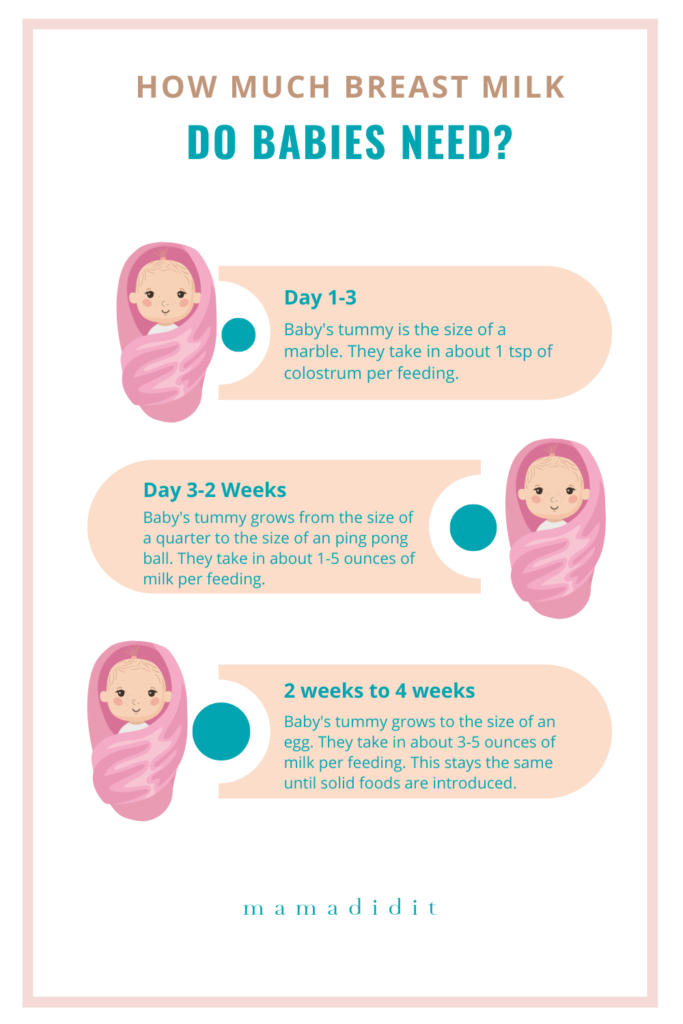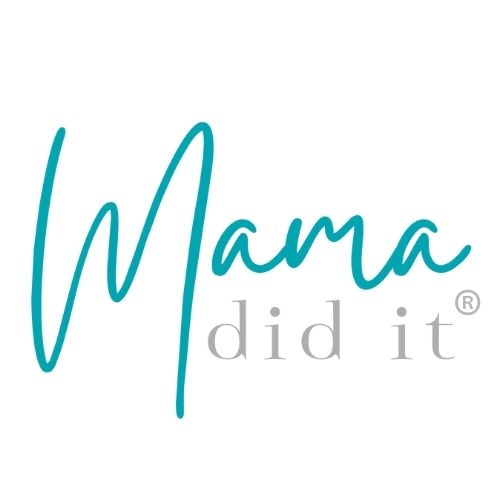It’s one of the most common concerns of a breastfeeding mother. How much breast milk do babies need? From baby’s tummy size to age, here are 5 ways to tell how much breast milk babies need.
As a postpartum nurse, I have been asked over and over again questions just like this, “Is my baby getting enough to eat?” or “How much breast milk do babies need?” It’s difficult to determine early milk flow, especially with a first baby.
Almost always, the answer is yes. It’s hard to tell the first couple of days of the breastfed infants life if this is the case, and there’s good reason for it.
The first milk that a mother makes is called colostrum. Colostrum is a thick, golden-colored substance that is nutrient-packed. While you are pregnant, your body is already making colostrum so it’s ready to go when baby is born.
Colostrum is different than mature breast milk. It prepares the baby’s gut for the amount of breast milk they will soon receive. When your baby nurses in the initial 24-hour period they are receiving a small amount of colostrum with each feeding. As long as your baby nurses every 2-3 hours for at least ten minutes, they most likely are getting their nutritional needs met.
The first week of breastfeeding can be challenging! From sore nipples to engorgement to breast milk transition, it’s not always smooth sailing. All of these issues usually work out within a few days. If you are experiencing soreness or pain the entire time you breastfeed, see a lactation consultant. Nursing your baby may hurt the first few seconds, but it shouldn’t hurt the whole feeding. Finding a support group can help you reach your goals.
How big is my baby’s stomach?

A newborn baby has a stomach the size of a marble. They don’t need large ounces of breast milk or large ounces of formula to meet their needs. A small amount is right for the first couple of days of life. In fact, each time your baby nurses the first two days, they receive about 1 teaspoon of colostrum per feeding, which is just right for them.
For exclusive breastfeeding, nurse your baby 8-12 times in 24 hours. You will need to wake breastfed babies up to feed the first several months. This is a good thing! Breast milk is digested quickly, and they will need more for their growth and development.
For formula-fed infants, feed every 3-4 hours until solids are introduced. Formula isn’t digested as quickly as breast milk, but your formula-fed babies will still need night feedings for some time.
How much breast milk do babies need?
By day 3, your baby’s tummy has grown to about the size of a quarter and your breasts are more than likely transitioning from colostrum to mature milk. This also means the volume is increasing. Baby’s tummy now holds about 1 ounce of milk per feeding.
By the end of the first week, baby’s stomach is about the size of a ping pong ball. When they nurse, they are taking in almost 2 ounces of milk with each feeding.
By two weeks of life, your baby’s stomach is continuing to expand to the size of an egg, and they are gaining a little weight every day. This age usually receives 3-5 ounces of milk with each feeding.
From 4 weeks until you introduce solid foods to your baby’s diet, your breast milk stays about the same as you enter the “maintain stage.” The American Academy of Pediatrics recommends babies be exclusively breastfed for the first six months of life (24 weeks of life) due to the health benefits. They rarely need any extra water, infant formula, cereals, or solid foods before this point.

According to Medela, “It is important to remember that breastfed infants take fewer but longer feeds as they get older, though their daily consumption remains about the same. This means that your little one may have less nursing sessions through the day, but will typically nurse for a longer period when they do. During the 3 – 6-month-old period, babies start to grow more slowly, so they don’t need a lot more milk at this time.”
How much breast milk do babies need?
It’s common to wonder if your body is making enough milk for your baby’s needs. Here are five ways to tell.
Are you getting enough protein to keep up with milk supply? Here’s my list of the best protein powders for breastfeeding moms.
1. Is your baby having enough wet diapers?
Baby’s need to have at least 1 wet and 1 dirty diaper on day 1. They need at least 2, by day 2. Then 3 by day 3. By day 4 they need to have 4 wets and 4 dirty diapers. And by day 5 they need to have 5 wets and 5 bowel movements every 24 hours.
If you are concerned about your milk production, it’s a good idea to count baby’s wets and dirty diapers for a couple of days.
2. Your breasts should feel heavy and full before feeding, and soft afterward.
Before your baby nurses, your breast should feel full and heavy. Once your baby is finished feeding, your breast should feel soft and empty. You and your baby may also feel relaxed and sleepy because of the release of oxytocin while feeding.
3. Weight Gain
It is common for a breastfed baby to lose weight at the beginning of the first week of life. They don’t receive a big volume of colostrum, plus they poop and pee some of their weight away. However, they should begin to stop losing weight and begin to gain weight as mom’s milk comes in.
Remember, breastfeeding is a supply and demand system and frequent feeding can help your baby gain weight quicker. By the time your baby is two weeks of age, they should be back to their birth weight.
A Baby’s hunger cues can alert you when to feed. If they are turning their head towards the breast, putting their fist in their mouth, licking their lips, or smacking, this is babys cues. Crying is a late sign of hunger. If they are crying to be fed, they have probably been hungry for about 30 minutes.
4. Number of Feedings
Another way to tell if your baby is getting enough milk is to count the number of times they are feeding. Breastfed babies should feed 8-12 times every 24 hours. Babies who aren’t getting enough breast milk may begin to sleep through feedings and get lazy at the breast. Feeding burns calories and if they aren’t getting enough, they will begin to maintain them as they can.
There are times when babies hit growth spurts usually starting at one months of age. You may notice they begin cluster feeding. Cluster feeding is when your baby feeds more frequently and rapidly empties your breast so it will make more. This causes the amount of milk in your breast to increase quickly. Usually, after 2-3 days of cluster feeding, they will go back to their normal routine.
5. Pre and Post Feeding Weight
If you would like to see an accurate reading of the amount of milk you are producing, make an appointment with a lactation consultant for a pre and post-feeding weight. Your lactation consultant can assess the baby’s latch and help you troubleshoot any problems you are having. During a pre and post-feeding consult, they will weigh breastfed infants before the baby nurses. Then they weigh again when they are done.
The amount of weight gained gives a great indicator for the amount of milk you are making. This may be the best way to see what your baby gets with feedings since a baby is better at emptying the breast than a breast pump.
Be sure to keep your pediatrician appointments for your baby. They monitor growth and can catch weight problems early on.
Concerned about your milk supply? Don’t miss my 12 ways on how to increase your breast milk supply, mother-baby nurse and lactation consultant approved!
Newborn Baby Sleeping too Much and Not Eating
It is normal for a newborn baby not to want to wake up and eat. In fact, a newborn doesn’t even begin to feel hungry until around two days old.
It is still crucial that your baby wakes up to feed every 2-3 hours. Feeding them frequently helps their body maintain blood sugar. This can be quite the task because they would rather sleep!
To help them wake up, take your babies clothes off. Yes, they will feel cold, but this helps them wake up. Tickle their feet until they start kicking around. Scratch their little heads until their eyes open. If your baby falls asleep at the breast, know this is normal and you aren’t doing anything wrong, but you need to wake them up.
The first couple of days, your body is making colostrum. Colostrum is exactly what your baby needs (see above), but it’s also hard work to get it out. It’s ok to let your baby rest at the breast for a minute or so, but then stimulate them to begin to suckle again. You can do this by scratching on their cheek or rubbing their head.
Don’t worry, it gets easier! Your milk begins to come in around day four for the first time mom. Once this happens, your baby will be eager at the breast most of the time. They will latch and feed until they’re full and satisfied. Until then, wake them every 2-3 hours to nurse and continue to keep them awake while at the breast.
Post may contain affiliate links
